7 JUNE 2010
YOUR WORDS
Readers are invited to add their comments to any story. Click on the article to see and add.
BTN DISTRIBUTION
BTN also goes out by email every Sunday night at midnight (UK time). To view this edition click here.
- ON THE SOAPBOX: Jonathan Buttery talks insurance and the ash problems
- Air Partner
- Aviation leaders gather in Berlin
- Barcelona takes to Cruz
- Birmingham base for new upmarket charter operation
- Bogota gains further European flights
- Bratislava gets grand hotel
- Chile airline takes first Airbus
- China portfolio to double over five years
- City Airline changes hands
- Delta gets the Yotel capsule
- easyBus adds Gatwick South from Central London
- Garuda comes back to Europe
- Lufthansa Technik offers cabin surveillance camera system
- PIA flies on at Barcelona
- Riga gets busy
- Ryanair shareholders finally get dividends
- Southend Airport on the upgrade trial
- Vueling goes for the connections
- Wataniya Airways in route expansion
- Zurich to San Francisco
- ON TOUR: Oman
- HAPPY TALK: Do not believe what you read?
The Business Travel News
PO Box 758
Edgware HA8 4QF
United Kingdom
info@btnews.co.uk
© 2022 Business Travel News Ltd.
Air Partner
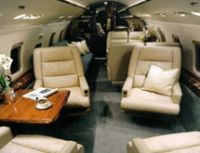 AIR PARTNER has launched an “empty sectors” consumer website, enabling potential private jet users to book flights on aircraft that would otherwise operate without passengers. The website locates real-time availability on private jets worldwide, by sector and aircraft, at prices up to 75% lower than conventional charter rates. For example, a six-seat private jet flight from London to Cannes, for the French Riviera, for £3,000. An empty sector (or empty leg) occurs when a pre-booked revenue charter has been reserved for a one-way flight only, either outbound or return. The operator will need to either position the aircraft to collect the passengers for a return or bring the aircraft back to its original location having flown the passengers to their chosen destination (leaving an empty sector on the return flight). www.emptysectors.com
AIR PARTNER has launched an “empty sectors” consumer website, enabling potential private jet users to book flights on aircraft that would otherwise operate without passengers. The website locates real-time availability on private jets worldwide, by sector and aircraft, at prices up to 75% lower than conventional charter rates. For example, a six-seat private jet flight from London to Cannes, for the French Riviera, for £3,000. An empty sector (or empty leg) occurs when a pre-booked revenue charter has been reserved for a one-way flight only, either outbound or return. The operator will need to either position the aircraft to collect the passengers for a return or bring the aircraft back to its original location having flown the passengers to their chosen destination (leaving an empty sector on the return flight). www.emptysectors.com
Birmingham base for new upmarket charter operation
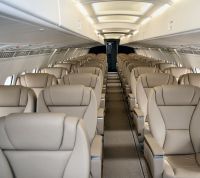 CELLO AVIATION is the name of a new upmarket large executive jet operation based at Birmingham Airport. Initially the airline will offer a 46-seat Avro ABJ (BAe 146-200), with about half the number of seats offered in a normal airline service. Cello says Birmingham has been chosen for the base due to its central location. The company expects that most of its business will come from sports teams, the entertainment industry and corporate hospitality. The aircraft has enough range to cover most destinations across Europe. The BAe/Avro 146 series has an exceptional short field performance as well as a low noise footprint enabling it to access environmentally-sensitive airports. www.flycello.com
CELLO AVIATION is the name of a new upmarket large executive jet operation based at Birmingham Airport. Initially the airline will offer a 46-seat Avro ABJ (BAe 146-200), with about half the number of seats offered in a normal airline service. Cello says Birmingham has been chosen for the base due to its central location. The company expects that most of its business will come from sports teams, the entertainment industry and corporate hospitality. The aircraft has enough range to cover most destinations across Europe. The BAe/Avro 146 series has an exceptional short field performance as well as a low noise footprint enabling it to access environmentally-sensitive airports. www.flycello.com
Chile airline takes first Airbus
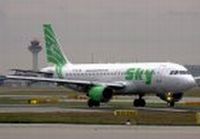 SKY AIRLINE, Chile’s second largest carrier, has taken delivery of two A320-200s, its first ever Airbus aircraft. Based in Santiago (Chile), Sky Airline flies to many of the country’s top destinations, including Antofagasta, Arica, Balmaceda, Calama, Concepción, Copiapó, El Salvador, Iquique, Puerto Montt, Punta Arenas and Temuco. Sky Airline also has international flights to Arequipa (Peru) and La Paz (Bolivia). Established in 2002 the airline flies passenger, postal and cargo air transport services. It also operates 11 Boeing 737-200s. www.skyairline.cl
SKY AIRLINE, Chile’s second largest carrier, has taken delivery of two A320-200s, its first ever Airbus aircraft. Based in Santiago (Chile), Sky Airline flies to many of the country’s top destinations, including Antofagasta, Arica, Balmaceda, Calama, Concepción, Copiapó, El Salvador, Iquique, Puerto Montt, Punta Arenas and Temuco. Sky Airline also has international flights to Arequipa (Peru) and La Paz (Bolivia). Established in 2002 the airline flies passenger, postal and cargo air transport services. It also operates 11 Boeing 737-200s. www.skyairline.cl
Delta gets the Yotel capsule
 DELTA AIRLINES has teamed up with Yotel to offer premium passengers landside benefits from the courtesy use of a Yotel cabin on arrival at Heathrow T4. The facilities include a working area, shower, bed, and free wi-fi access. The Yotel capsule hotel concept launched in 2007 at Gatwick Airport, and has since opened properties at Heathrow and Amsterdam Schiphol. The Yotel Heathrow Airport is located on the mezzanine level of T4, accessed by the escalators next to Boots in the departures hall, or the lifts by WHSmith in Arrivals. Delta flies into Heathrow from Atlanta, Detroit, Minneapolis and New York-JFK. www.yocompany.biz
DELTA AIRLINES has teamed up with Yotel to offer premium passengers landside benefits from the courtesy use of a Yotel cabin on arrival at Heathrow T4. The facilities include a working area, shower, bed, and free wi-fi access. The Yotel capsule hotel concept launched in 2007 at Gatwick Airport, and has since opened properties at Heathrow and Amsterdam Schiphol. The Yotel Heathrow Airport is located on the mezzanine level of T4, accessed by the escalators next to Boots in the departures hall, or the lifts by WHSmith in Arrivals. Delta flies into Heathrow from Atlanta, Detroit, Minneapolis and New York-JFK. www.yocompany.biz
Lufthansa Technik offers cabin surveillance camera system
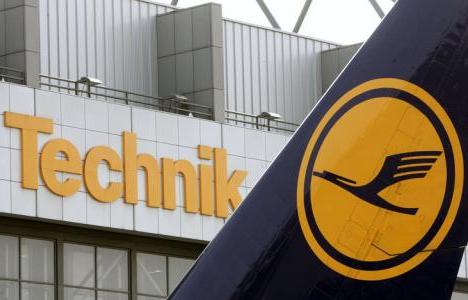 “AEROSIGHT" has been demonstrated by Lufthansa Technik, a concept that enables pilots to monitor cockpit access, and cabin and cargo areas, both during the day and at night. "aerosight" can simultaneously handle up to 16 viewing cameras in the pressurised area of an aircraft. The camera system automatically switches between a coloured day view mode and an infrared night view mode. Lufthansa Technik has developed "aerosight" for an undisclosed launch customer and will start to offer the system for other clients in the first quarter of 2011. www.lufthansa-technik.com
“AEROSIGHT" has been demonstrated by Lufthansa Technik, a concept that enables pilots to monitor cockpit access, and cabin and cargo areas, both during the day and at night. "aerosight" can simultaneously handle up to 16 viewing cameras in the pressurised area of an aircraft. The camera system automatically switches between a coloured day view mode and an infrared night view mode. Lufthansa Technik has developed "aerosight" for an undisclosed launch customer and will start to offer the system for other clients in the first quarter of 2011. www.lufthansa-technik.com
Ryanair shareholders finally get dividends
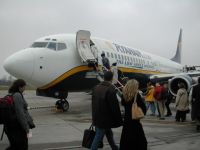 RYANAIR is to pay a dividend to its shareholders in October using funds previously allocated for the purchase of new aircraft from Boeing. Floated in 1997, the shares, in common with other airlines, have been spectacular with their ups and downs peaking over €6 (Spring 2007) and dropping towards €2 by the autumn of last year. Ryanair reported a profit of €319m after tax for its fiscal year ended 31 March, as against €105 for the previous 12 months. Scheduled services revenue grew less than 1% as average fares fell 13% and ancillary revenue jumped 10.9% to €663.6m. 51 new aircraft arrived but Ryanair's statement did not give details of departures nor of routes dropped. It is now the world’s most expensive airline for anyone carrying more than 15kg of luggage. Ryanair is forecasting 73.5m passengers in the current financial year.
RYANAIR is to pay a dividend to its shareholders in October using funds previously allocated for the purchase of new aircraft from Boeing. Floated in 1997, the shares, in common with other airlines, have been spectacular with their ups and downs peaking over €6 (Spring 2007) and dropping towards €2 by the autumn of last year. Ryanair reported a profit of €319m after tax for its fiscal year ended 31 March, as against €105 for the previous 12 months. Scheduled services revenue grew less than 1% as average fares fell 13% and ancillary revenue jumped 10.9% to €663.6m. 51 new aircraft arrived but Ryanair's statement did not give details of departures nor of routes dropped. It is now the world’s most expensive airline for anyone carrying more than 15kg of luggage. Ryanair is forecasting 73.5m passengers in the current financial year.
www.ryanair.com
Wataniya Airways in route expansion
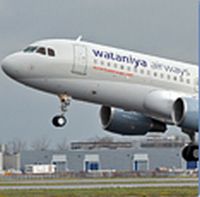 KUWAIT'S WATANIYA AIRWAYS has announced the launch of a new route to the Austrian capital, Vienna. The carrier will operate three times per week with an Airbus A320 in a First Class and Premium Economy layout. This is the airline’s second European destination after Rome. Wataniya is listed on the Kuwait Stock Exchange and made its inaugural flight in January 2009. It now flies from Kuwait to most of the capitals in the Middle East. Rather than the main international facility at Kuwait, Wataniya uses the exclusive Sheikh Saad Terminal, essentially an executive aviation facility boasting Fast Track immigration, valet and concierge services, and what is essentially a private lounge. www.wataniyaairways.com
KUWAIT'S WATANIYA AIRWAYS has announced the launch of a new route to the Austrian capital, Vienna. The carrier will operate three times per week with an Airbus A320 in a First Class and Premium Economy layout. This is the airline’s second European destination after Rome. Wataniya is listed on the Kuwait Stock Exchange and made its inaugural flight in January 2009. It now flies from Kuwait to most of the capitals in the Middle East. Rather than the main international facility at Kuwait, Wataniya uses the exclusive Sheikh Saad Terminal, essentially an executive aviation facility boasting Fast Track immigration, valet and concierge services, and what is essentially a private lounge. www.wataniyaairways.com
HAPPY TALK: Do not believe what you read?
(Part 2)
Since we took Ryanair to task last week we think it only fair to point out that a British Airways press release was equally misleading, although in this case it was a pure mistake, one that the press office should have picked up themselves.
BRITISH AIRWAYS IS TAKING MORE THAN 2.5 MILLION CUSTOMERS TO SOUTH AFRICA DURING THE WORLD CUP.
As far as we can see the 2.5m refers to the number of people British Airways will fly on its own systems in July (if the strike threat is lifted).
British Airways now say that they will fly 70,000 people to the World Cup, but AERBT thinks that this figure too is misleading.
With 19 flights per week from Heathrow to South Africa, and say 350 passengers per flight, that comes to 6,650. Spread over five weeks the figure is 35,000.
Do not believe what you read. The BA revised figure of passengers flying to South Africa is in fact passengers flying to South Africa and coming back.
What BA does not know is just how many will want an earlier return journey if England are knocked out?
And in any event the team flew down on Virgin Atlantic!
ON THE SOAPBOX: Jonathan Buttery talks insurance and the ash problems
With the resultant problems associated with Iceland’s volcanic eruption likely to be with us for some time this month's SOAPBOX features Jonathan Buttery, Director of Voyager Insurance Services Ltd and a former Chairman of the Association of Travel Insurance Intermediaries (ATII), and expert in his field.
 We need to set the record straight about recovering costs resulting from volcanic ash disruption.
We need to set the record straight about recovering costs resulting from volcanic ash disruption.
The recent suspension of flights caused by the volcanic ash cloud from Iceland has obviously caused much inconvenience and frustration for airline passengers. Regrettably, this frustration has been exacerbated by inexpert advice to travellers about how they may recover costs incurred as a result of this exceptional event.
The reality is that, despite popular misconception, only very limited insurance cover is available under most travel insurance policies for such an event. The closure of European airspace for such a long period is totally unprecedented and, as such, is not a contingency that is covered under the vast majority of insurance policies.
An insurance policy is a contract like any other, which provides protection against specific perils as stated in the policy wording in return for the agreed premium paid. Disruption to air travel caused by volcano eruptions is simply not an event that is insured. Most policies also specifically exclude claims relating to the withdrawal of transport services on the instructions of the Civil Aviation Authority, Port authorities or similar bodies internationally.
While there is an understandable disappointment that travel insurance does not cover this type of event, it is important to recognise that any policy that tried to cover every possible event, however unprecedented or unlikely, would be prohibitively expensive. As such it would be completely uncompetitive in a marketplace that is driven mainly by the cheapest possible price. Such a broad policy would be economically unsustainable which is why they do not exist.
While each individual may be looking for a relatively small amount and therefore hopes or expects the insurers to take a sympathetic view, by the time the huge numbers involved are multiplied into the calculation it becomes simply impossible for insurers to consider on a goodwill basis.
We ourselves are in discussion with various insurers, exploring ways to provide wider cover for such events. Travellers' memories can be very short, however, and people are often very reluctant to pay any extra, even while the problem is still fresh in everyone’s mind. Of those that responded to a recent survey by Holiday Extras, 27% said they felt natural disaster insurance was a waste of money and only 9% said they would definitely pay for such cover.
While insurers do go to great lengths and are in the business of providing the best protection possible, there are limitations as there are with any business and I hope this provides a better understanding of the reasons why.
I also hope this will help prevent further unnecessary frustration for the unfortunate travellers who have been wrongly led to believe that compensation for this event from insurers is their right.
Jonathan Buttery
Aviation leaders gather in Berlin
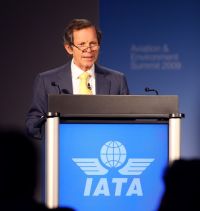
Bogota gains further European flights
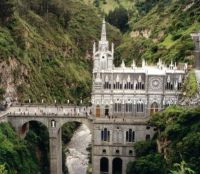 LUFTHANSA is expanding its services to South America. With the introduction of the 2010/2011 winter timetable on 31 October, the airline will resume flights to the Colombian capital Bogota. Five flights per week are scheduled between Frankfurt and the Colombian capital, operated by an Airbus A340. Lufthansa served Bogota, which is situated in the north western corner of South America, until 2002. Once this service is resumed, Lufthansa will offer its customers a total of 60 flights per week to four destinations in South America. www.lufthansa.com
LUFTHANSA is expanding its services to South America. With the introduction of the 2010/2011 winter timetable on 31 October, the airline will resume flights to the Colombian capital Bogota. Five flights per week are scheduled between Frankfurt and the Colombian capital, operated by an Airbus A340. Lufthansa served Bogota, which is situated in the north western corner of South America, until 2002. Once this service is resumed, Lufthansa will offer its customers a total of 60 flights per week to four destinations in South America. www.lufthansa.com
China portfolio to double over five years
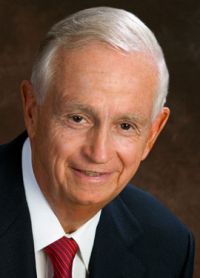 MARRIOTT INTERNATIONAL has plans to double its China portfolio over the next five years. The multi-national, based in Bethesda, MD, expects to have 60 hotels open across six brands by year-end 2010. This figure includes eight prestigious Ritz-Carltons, two opening this year in Hong Kong and Shanghai Pudong. To put a true perspective on China, the country is expected to host 2.1bn domestic and international tourists this year, an increase of 12% over 2009. “Within the next ten years, China is expected to be the world’s single largest source of international tourism and its number-one travel destination,” according to J. W. Marriott Jr, Chairman and Chief Executive Officer of Marriott International. www.marriott.com
MARRIOTT INTERNATIONAL has plans to double its China portfolio over the next five years. The multi-national, based in Bethesda, MD, expects to have 60 hotels open across six brands by year-end 2010. This figure includes eight prestigious Ritz-Carltons, two opening this year in Hong Kong and Shanghai Pudong. To put a true perspective on China, the country is expected to host 2.1bn domestic and international tourists this year, an increase of 12% over 2009. “Within the next ten years, China is expected to be the world’s single largest source of international tourism and its number-one travel destination,” according to J. W. Marriott Jr, Chairman and Chief Executive Officer of Marriott International. www.marriott.com
easyBus adds Gatwick South from Central London
 EASYBUS added a direct service to Gatwick Airport's South Terminal from Earls Court/West Brompton in west London last week. Departures are offered up to every 15 minutes and the journey takes just over an hour, with prices starting at £2 for early bookers travelling at off-peak times. easyBus has also taken the opportunity to start the new timetable a full hour earlier, with departures from London starting at 03:00, making it the only dedicated London to Gatwick airport transfer service at this hour. The separate service to Gatwick North continues, and with an increased frequency. www.easybus.co.uk
EASYBUS added a direct service to Gatwick Airport's South Terminal from Earls Court/West Brompton in west London last week. Departures are offered up to every 15 minutes and the journey takes just over an hour, with prices starting at £2 for early bookers travelling at off-peak times. easyBus has also taken the opportunity to start the new timetable a full hour earlier, with departures from London starting at 03:00, making it the only dedicated London to Gatwick airport transfer service at this hour. The separate service to Gatwick North continues, and with an increased frequency. www.easybus.co.uk
PIA flies on at Barcelona
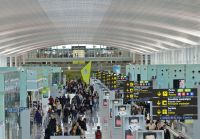 PAKISTAN INTERNATIONAL AIRLINES, in what must be described as an unusual move, has introduced a twice weekly service from Barcelona to Chicago. The airline operates a two-class Boeing 777-300ER for the 9hrs 30mins flight. The airline also flies twice a week from Barcelona to Lahore (and on to Karachi), and twice per week to Islamabad. Barcelona is gaining popularity as a hub, its 24/7 operation under-utilised. Current long haul operators include American Airlines, Delta, US Airways, Avianca, to be shortly followed by Air Canada and Qatar Airways. www.piac.com.pk
PAKISTAN INTERNATIONAL AIRLINES, in what must be described as an unusual move, has introduced a twice weekly service from Barcelona to Chicago. The airline operates a two-class Boeing 777-300ER for the 9hrs 30mins flight. The airline also flies twice a week from Barcelona to Lahore (and on to Karachi), and twice per week to Islamabad. Barcelona is gaining popularity as a hub, its 24/7 operation under-utilised. Current long haul operators include American Airlines, Delta, US Airways, Avianca, to be shortly followed by Air Canada and Qatar Airways. www.piac.com.pk
Southend Airport on the upgrade trial
 SOUTHEND AIRPORT should have its railway station open some time in the autumn offering direct services to London’s Liverpool Street by National Express East Anglia. There are various interchange stations along the route, the most important being Stratford Regional for the Olympic Park, London Underground, London Overground and the DLR. Work on the extended runway will start in October and should be completed in 12 months by which time the new terminal, adjoining the station, is planned to be finished. By the time of the 2012 Olympics, Southend Airport will be unrecognisable from its present status. www.southendairport.com
SOUTHEND AIRPORT should have its railway station open some time in the autumn offering direct services to London’s Liverpool Street by National Express East Anglia. There are various interchange stations along the route, the most important being Stratford Regional for the Olympic Park, London Underground, London Overground and the DLR. Work on the extended runway will start in October and should be completed in 12 months by which time the new terminal, adjoining the station, is planned to be finished. By the time of the 2012 Olympics, Southend Airport will be unrecognisable from its present status. www.southendairport.com
Zurich to San Francisco
 SWISS INTERNATIONAL AIR LINES has commenced a new non-stop service between Zurich and San Francisco. To mark the route the airline has come up with a “first” in its corporate history: HB-JMJ an Airbus A340 is sporting a colourful and flowery design together with striking “San Francisco” lettering as a tribute to the West Coast city’s famed flower power past. HB-JMJ is the first A340 to be equipped with the new SWISS Business cabin which, amongst other innovations, provides seats that feature an innovative air cushion whose firmness can be swiftly and flexibly adjusted to individual wishes. Under current plans, a second A340 should have the new SWISS Business cabin installed by mid-July, enabling the new product to be offered to all travellers on Zurich – San Francisco flights. www.swiss.com
SWISS INTERNATIONAL AIR LINES has commenced a new non-stop service between Zurich and San Francisco. To mark the route the airline has come up with a “first” in its corporate history: HB-JMJ an Airbus A340 is sporting a colourful and flowery design together with striking “San Francisco” lettering as a tribute to the West Coast city’s famed flower power past. HB-JMJ is the first A340 to be equipped with the new SWISS Business cabin which, amongst other innovations, provides seats that feature an innovative air cushion whose firmness can be swiftly and flexibly adjusted to individual wishes. Under current plans, a second A340 should have the new SWISS Business cabin installed by mid-July, enabling the new product to be offered to all travellers on Zurich – San Francisco flights. www.swiss.com
Readers interested in aviation history might like to know that the Vickers Viscount Aviation Society is organising a special day at the Imperial War Museum’s Duxford facility on Saturday 31 July. Visitors will be able to view the world’s oldest remaining Viscount G-ALWF c/n 5, a Duxford resident.
The Vickers Viscount, designed by a team lead by Sir George Edwards, first flew in 1948, the last withdrawn by British Airways 1985, with British World Airlines continuing operations until 1995. The Viscount was a trend setter, very comfortable to fly in and winning international sales success. Some 445 were built making it arguably Britain’s most successful air transport aircraft. www.vickersviscount.net http://duxford.iwm.org.uk
Barcelona takes to Cruz
 ALEX CRUZ, who created Click Airlines in 2006 and then masterminded a merger with Spanish rival Vueling last year, was in fine form last week explaining to the European media that his "Vueling-to-Vueling" concept (see below) did not break his "keep the cost down" guideline, the connection desk virtually the only ongoing outlay. Vueling is now Barcelona's biggest operator with 24% of passengers. At a press briefing conducted entirely in English, Cruz, whose CV includes spells with American Airlines, Sabre and Accenture, the global management consultants, said that 2011 could be a year of consolidation, although a London route, whilst not a priority, was a consideration. Vueling operates from Bilbao, La Coruna and Seville to Heathrow. Vueling currently operates a total of 98 routes in 48 airports, all major hubs, of which six (Barcelona, Bilbao Madrid, Malaga, Seville and Valencia) are the company's operating bases. The airline has a fleet of 37 Airbus A320s and expects to fly 11m passengers this year. The arrival of Ryanair (see last week's AERBT) in the autumn did not seem to concern Cruz, who pointed out that the Irish airline had received no concessions from the airport in terms of discounts, self-handling, and would have to use air bridges, a particular loathing of Michael O'Leary. www.vueling.com
ALEX CRUZ, who created Click Airlines in 2006 and then masterminded a merger with Spanish rival Vueling last year, was in fine form last week explaining to the European media that his "Vueling-to-Vueling" concept (see below) did not break his "keep the cost down" guideline, the connection desk virtually the only ongoing outlay. Vueling is now Barcelona's biggest operator with 24% of passengers. At a press briefing conducted entirely in English, Cruz, whose CV includes spells with American Airlines, Sabre and Accenture, the global management consultants, said that 2011 could be a year of consolidation, although a London route, whilst not a priority, was a consideration. Vueling operates from Bilbao, La Coruna and Seville to Heathrow. Vueling currently operates a total of 98 routes in 48 airports, all major hubs, of which six (Barcelona, Bilbao Madrid, Malaga, Seville and Valencia) are the company's operating bases. The airline has a fleet of 37 Airbus A320s and expects to fly 11m passengers this year. The arrival of Ryanair (see last week's AERBT) in the autumn did not seem to concern Cruz, who pointed out that the Irish airline had received no concessions from the airport in terms of discounts, self-handling, and would have to use air bridges, a particular loathing of Michael O'Leary. www.vueling.com
Bratislava gets grand hotel
 KEMPINSKI HOTEL RIVER PARK BRATISLAVA is aiming to become the Slovak capital‘s leading luxury business hotel. With a ‘soft’ opening last week it is the dominant feature of River Park, one of the largest projects in the city's history. It is located within a complex of interconnected buildings: shops, bars, cafes, restaurants, apartments and offices. The new development nestles on the bank of the River Danube, under the majestic Bratislava Castle and within walking distance to the Old Town with its numerous historical sites. Many of the eight-storey hotel’s 231 guest rooms and suites offer stunning views over the Danube and the city skyline. www.kempinski.com
KEMPINSKI HOTEL RIVER PARK BRATISLAVA is aiming to become the Slovak capital‘s leading luxury business hotel. With a ‘soft’ opening last week it is the dominant feature of River Park, one of the largest projects in the city's history. It is located within a complex of interconnected buildings: shops, bars, cafes, restaurants, apartments and offices. The new development nestles on the bank of the River Danube, under the majestic Bratislava Castle and within walking distance to the Old Town with its numerous historical sites. Many of the eight-storey hotel’s 231 guest rooms and suites offer stunning views over the Danube and the city skyline. www.kempinski.com
City Airline changes hands
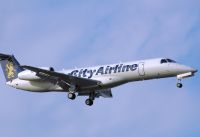 CITY AIRLINE, based in Gothenburg, is to be sold to four members of its management team lead by current Managing Director Jimmie Bergqvist. Behind the buyout is a decision by the airline’s owner, 77-year-old Lars Magnusson, to shelve expansion plans including a number of new routes from Gothenburg Landvetter Airport during the autumn of 2010. The airline flies within Scandinavia and Northern Europe, and to Birmingham and Manchester in the United Kingdom. Mr Magnusson says that the problems associated with the Iceland volcano have put unprecedented strains on all airlines both in management and financial terms. He felt it was time to retire but will remain in an advisory capacity. www.cityairline.com
CITY AIRLINE, based in Gothenburg, is to be sold to four members of its management team lead by current Managing Director Jimmie Bergqvist. Behind the buyout is a decision by the airline’s owner, 77-year-old Lars Magnusson, to shelve expansion plans including a number of new routes from Gothenburg Landvetter Airport during the autumn of 2010. The airline flies within Scandinavia and Northern Europe, and to Birmingham and Manchester in the United Kingdom. Mr Magnusson says that the problems associated with the Iceland volcano have put unprecedented strains on all airlines both in management and financial terms. He felt it was time to retire but will remain in an advisory capacity. www.cityairline.com
Garuda comes back to Europe
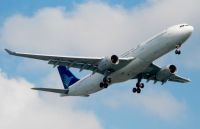 INDONESIA’S NATIONAL AIRLINE, Garuda Indonesia, is back in Europe after a six year absence. Last week it launched a daily flight from Jakarta to Amsterdam via Dubai. A two-class Airbus A330 is used on the service. It is one of several major European destinations which the revitalised carrier intends to add to its fast-growing network over the next four years, including Frankfurt, London, Paris and Rome. Garuda becomes the first Indonesian airline to reopen flights to Europe after the European Union’s (EU) ban prohibiting Indonesian carriers from operating in European airspace was lifted in July last year. www.garuda-indonesia.com
INDONESIA’S NATIONAL AIRLINE, Garuda Indonesia, is back in Europe after a six year absence. Last week it launched a daily flight from Jakarta to Amsterdam via Dubai. A two-class Airbus A330 is used on the service. It is one of several major European destinations which the revitalised carrier intends to add to its fast-growing network over the next four years, including Frankfurt, London, Paris and Rome. Garuda becomes the first Indonesian airline to reopen flights to Europe after the European Union’s (EU) ban prohibiting Indonesian carriers from operating in European airspace was lifted in July last year. www.garuda-indonesia.com
Riga gets busy
 AIR BALTIC, the National airline of Latvia, has had a very busy few weeks introducing new destinations. This summer it will operate 27 routes more than in 2009. It now serves 80 destinations from its home base at Riga. Amongst the new destinations are Amman (twice weekly), Beirut (twice weekly) and Madrid (three times per week), whilst in its own region new are Stockholm – Tallinn, and Stockholm – Oulu. www.airbaltic.com
AIR BALTIC, the National airline of Latvia, has had a very busy few weeks introducing new destinations. This summer it will operate 27 routes more than in 2009. It now serves 80 destinations from its home base at Riga. Amongst the new destinations are Amman (twice weekly), Beirut (twice weekly) and Madrid (three times per week), whilst in its own region new are Stockholm – Tallinn, and Stockholm – Oulu. www.airbaltic.com
Vueling goes for the connections
 VUELING will start connecting passengers through its Barcelona El Prat hub from 5 July, a move that it expects will allow it to carry 250,000-350,000 additional travellers this year and at least one million extra passengers in 2011. From announcing the project, in less than 24 hours the airline’s web site recorded 18,000 enquiries. The new connectivity will provide passengers with 418 "Vueling-to-Vueling" city-pairs via Barcelona. Customers will buy only one ticket and baggage will be through tagged, the system set up for a minimum 90-minute connection. El Prat’s Terminal 1 is just 12 months old, a fine building in itself and with its fully automatic baggage system is perfect for such an innovative and ambitious project. Waiting passengers will be tempted by various offerings including VAT redemption. Should any routes provide outstanding figures Vueling will then be able to consider direct services. www.vueling.com
VUELING will start connecting passengers through its Barcelona El Prat hub from 5 July, a move that it expects will allow it to carry 250,000-350,000 additional travellers this year and at least one million extra passengers in 2011. From announcing the project, in less than 24 hours the airline’s web site recorded 18,000 enquiries. The new connectivity will provide passengers with 418 "Vueling-to-Vueling" city-pairs via Barcelona. Customers will buy only one ticket and baggage will be through tagged, the system set up for a minimum 90-minute connection. El Prat’s Terminal 1 is just 12 months old, a fine building in itself and with its fully automatic baggage system is perfect for such an innovative and ambitious project. Waiting passengers will be tempted by various offerings including VAT redemption. Should any routes provide outstanding figures Vueling will then be able to consider direct services. www.vueling.com
ON TOUR: Oman
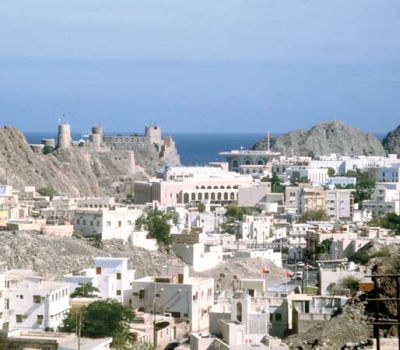 The Sultanate of Oman is situated on the southeast coast of the Arabian Peninsula. It borders the United Arab Emirates (UAE) on the northwest, Saudi Arabia on the west and Yemen on the southwest. It is about eight hours’ flying time from London, passing over, in order, Bahrain, Dubai and Abu Dhabi before landing at a small modern airport and landside in record time. Not part of the UAE, Oman is independent and you are made very welcome.
The Sultanate of Oman is situated on the southeast coast of the Arabian Peninsula. It borders the United Arab Emirates (UAE) on the northwest, Saudi Arabia on the west and Yemen on the southwest. It is about eight hours’ flying time from London, passing over, in order, Bahrain, Dubai and Abu Dhabi before landing at a small modern airport and landside in record time. Not part of the UAE, Oman is independent and you are made very welcome.
Strategically Oman is important, bordering to the south the Arabian Sea, and to the northeast the Gulf of Oman opposite Iran. All shipping for the Persian Gulf has to pass through the narrow Straits. In fact its location has been the bedrock of the country over the years, the meeting point of traders from India and those from Africa to the south. The European explorers of the 15th century, and their colonial masters, took more than a passing interest.
Oman has historically possessed Gwadar, now in Pakistan (until 1955), and also Zanzibar, subject of a bloody takeover in 1964.
Very influential were the Portuguese for 200 years, Muscat, now the capital, a vital port on the way to the East. In the late 18th century the newly established Sultanate signed the first in a series of friendship treaties with Britain. Over time, Oman's dependence on British political and military advisors increased, but it never became a British colony. In 1970, Qaboos bin Said al-Said overthrew the restrictive rule of his father and has ruled ever since. His extensive modernization programme has opened the country to the outside world while preserving the longstanding close ties with the UK. Oman's moderate, independent foreign policy has sought to maintain good relations with all Middle Eastern countries.
Oman Air
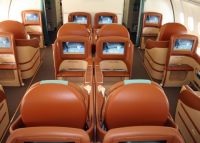 You can fly to Oman from Europe on various carriers but the recommended way is via Oman Air, which dates its history back as far as 1970. In 2007 it was recapitalised by the government, introducing long haul services.
You can fly to Oman from Europe on various carriers but the recommended way is via Oman Air, which dates its history back as far as 1970. In 2007 it was recapitalised by the government, introducing long haul services.
Oman Air now is a top quality international carrier, small by anyone’s standard but like its local rivals offering typical Arab quality hospitality. For the most part both the operating and cabin crews are of national origin, with the rules flexible. An airline that flies to Bangkok needs Thai speakers. Perhaps the only criticism of a very professionally run operation is a certain lack of experience from the staff, but that will come in time.
Quite frankly there is not a lot to choose between Oman Air’s First Class and Business Class. The difference is exclusivity and privacy which you gain in the front cabin where there are just six seats laid out 1+2+1, the same as Business Class. The lie-flat seats are even larger (both with easy to use controls). The digital IFE TV screens are bigger (22” against 17”) and screens slide up to give total seclusion. On European flights, in all parts of the aircraft, travellers can use OnAir’s in-flight internet and phone service, a very useful working tool to have on a long flight.
The Business Class menu looks inviting and is inviting. Proper large tables are hidden away in the seats allowing the staff to offer a fine service with plenty of room for all the tableware. No wobbling either! A five course menu is provided (including an excellent soup) and a first-rate wine list too. It looks, and is, a quality product.
The Oman Grand Mosque
 In 1992 Sultan Qaboos directed that his country should have a Grand Mosque. Construction commenced in 1995 and the building work took over six years. The result is imposing and well worth a visit. Ladies should be careful to cover up, (head, shoulders and knees – though the heat makes this sensible anyway). The female wardens are helpful, and indeed experts in making the cover-up stylish.
In 1992 Sultan Qaboos directed that his country should have a Grand Mosque. Construction commenced in 1995 and the building work took over six years. The result is imposing and well worth a visit. Ladies should be careful to cover up, (head, shoulders and knees – though the heat makes this sensible anyway). The female wardens are helpful, and indeed experts in making the cover-up stylish.
A major feature is the 70m × 60m carpet which covers the floor of the main prayer hall. It contains 1,700,000 knots, weighs 21 tonnes and took four years to produce. 28 colours in varying shades were used, the majority obtained from traditional vegetable dyes. Produced by Iran Carpet Company it is the second largest single piece carpet in the world. Equally striking is the main chandelier above the praying hall. It is 14m tall.
Muscat Souk
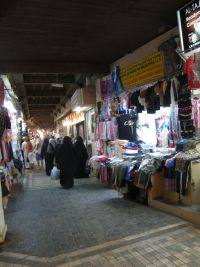 OK it is not as large as the Grand Bazaar in Istanbul or Cairo's massive Khan el Khalili market, but Muscat’s souk is still an intriguing place to wander about for an hour or two, looking at the ‘bargains’ and wondering whether they were made locally or in China. Built in traditional style it offers silver jewellery, intricately hand-made ‘Khanjars’ and other handicrafts. Shoes and sports equipment, carpets, clothes, lingerie, perfumes, leather goods, trinkets and Omani silver handicrafts are available. Haggling is part of the sale.
OK it is not as large as the Grand Bazaar in Istanbul or Cairo's massive Khan el Khalili market, but Muscat’s souk is still an intriguing place to wander about for an hour or two, looking at the ‘bargains’ and wondering whether they were made locally or in China. Built in traditional style it offers silver jewellery, intricately hand-made ‘Khanjars’ and other handicrafts. Shoes and sports equipment, carpets, clothes, lingerie, perfumes, leather goods, trinkets and Omani silver handicrafts are available. Haggling is part of the sale.
If the ancient souk is not for you (and this one is not that ancient) Muscat has plenty of fully air conditioned shopping malls, Bond Street in the desert, with the finest international cuisine close at hand.
Muscat has also found its niche as a cruise port on the regular run from Dubai and also Mumbai and the Maldives. The QM2 has squeezed into the harbour.
The Museum of Omani Heritage
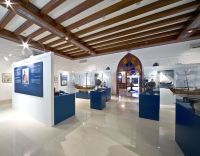 In the centre of Muscat the former home of the Al Zubair family has been turned into a museum, personally administrated by His Excellency Mohammad Al Zubair. It consists of over 5,000 specially selected, inherited or donated pieces spanning a number of centuries and regions that reflect Oman’s rich cultural heritage and unique identity. Included are traditional Omani weaponry, jewellery, costume, household utensils and furniture, early European maps and prints of the Arabian Peninsula and East Africa, early photographs, satellite images, coins, stamps, musical instruments, documents, manuscripts and books. The Museum also features traditional Omani architecture, a falaj and traditional fishing vessels.
In the centre of Muscat the former home of the Al Zubair family has been turned into a museum, personally administrated by His Excellency Mohammad Al Zubair. It consists of over 5,000 specially selected, inherited or donated pieces spanning a number of centuries and regions that reflect Oman’s rich cultural heritage and unique identity. Included are traditional Omani weaponry, jewellery, costume, household utensils and furniture, early European maps and prints of the Arabian Peninsula and East Africa, early photographs, satellite images, coins, stamps, musical instruments, documents, manuscripts and books. The Museum also features traditional Omani architecture, a falaj and traditional fishing vessels.
Over four decades, The Zubair Corporation has expanded and diversified, bringing new business thinking from around the world into the Sultanate of Oman to help build a vibrant and modern nation. Today it is a group with over 60 wholly owned companies, subsidiaries and associates in Oman, the Middle East, India, the Far East, Europe and the USA.
The Zubair Corporation's portfolio comprises investments, automotive, energy, real estate and construction, electric, tourism, furnishing, home and business solutions, information and communication technologies, cultural heritage and publishing.
The progress of The Zubair Corporation in many ways reflects the development of the Sultanate, with the Corporation playing a key role in Oman becoming a respected contributor to international trade and business.
Shangri-La's Barr Al Jissah Resort and Spa
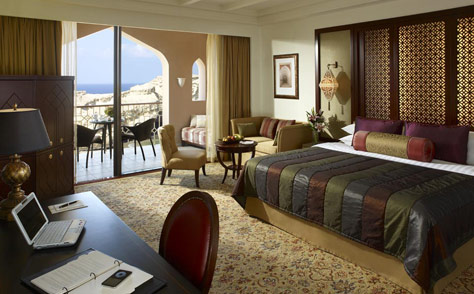 The Shangri-La's Barr Al Jissah Resort and Spa, a luxurious three-hotel resort community, nestles in a dramatic setting of rugged mountains and truly inviting beaches. It is about 35 miles from the international airport, 45 minutes, except during the rush hour. Muscat City is 15 minutes away with complementary shuttle provided.
The Shangri-La's Barr Al Jissah Resort and Spa, a luxurious three-hotel resort community, nestles in a dramatic setting of rugged mountains and truly inviting beaches. It is about 35 miles from the international airport, 45 minutes, except during the rush hour. Muscat City is 15 minutes away with complementary shuttle provided.
Al Husn (The Castle) is Shangri La at its best, with a level of service, amenities and privileges suitable for the most discerning of travellers. Within the complex there are eight restaurants serving a variety of both Middle East and international food. Pork is not available but the drinking rules are quite relaxed. Expatriates confirm that the Sultanah restaurant in Al Husn is one of the finest restaurants in Oman.
Al Bandar (The Town) is the resort’s mid-range property. The ballroom provides banquet-style seating for up to 700 people. There are 11 conference rooms. ‘Lazy River’ provides a relaxing way of 'commuting' around the resort, simply floating along in the man-made current from pool to pool and joins the property to Al Waha (The Oasis), Oman's first dedicated leisure hotel dominated by a large swimming pool complex.
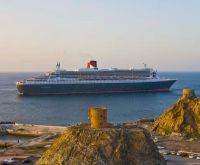 AERBT's visit to Muscat was short, providing an excellent respite on the way to Bangkok. If your final destination is on the Oman Air route map it is very much worthwhile considering as a stopover, vastly different from the Dubai metropolis, and the offerings of Abu Dhabi, Bahrain and Qatar. The Sultanate of Oman has a coastline some 1500 miles long and is home to about 2.4m people. Next time AERBT is going to explore! www.omantourism.gov.om www.shangri-la.com www.zubaircorp.com www.omanair.com
AERBT's visit to Muscat was short, providing an excellent respite on the way to Bangkok. If your final destination is on the Oman Air route map it is very much worthwhile considering as a stopover, vastly different from the Dubai metropolis, and the offerings of Abu Dhabi, Bahrain and Qatar. The Sultanate of Oman has a coastline some 1500 miles long and is home to about 2.4m people. Next time AERBT is going to explore! www.omantourism.gov.om www.shangri-la.com www.zubaircorp.com www.omanair.com


